With sweet-savory ground chicken, scrambled eggs, and green vegetables on top of fluffy steamed rice, Soboro Don (Ground Chicken Bowl) is a Japanese comfort meal for kids and adults and is effortlessly easy to pull together!
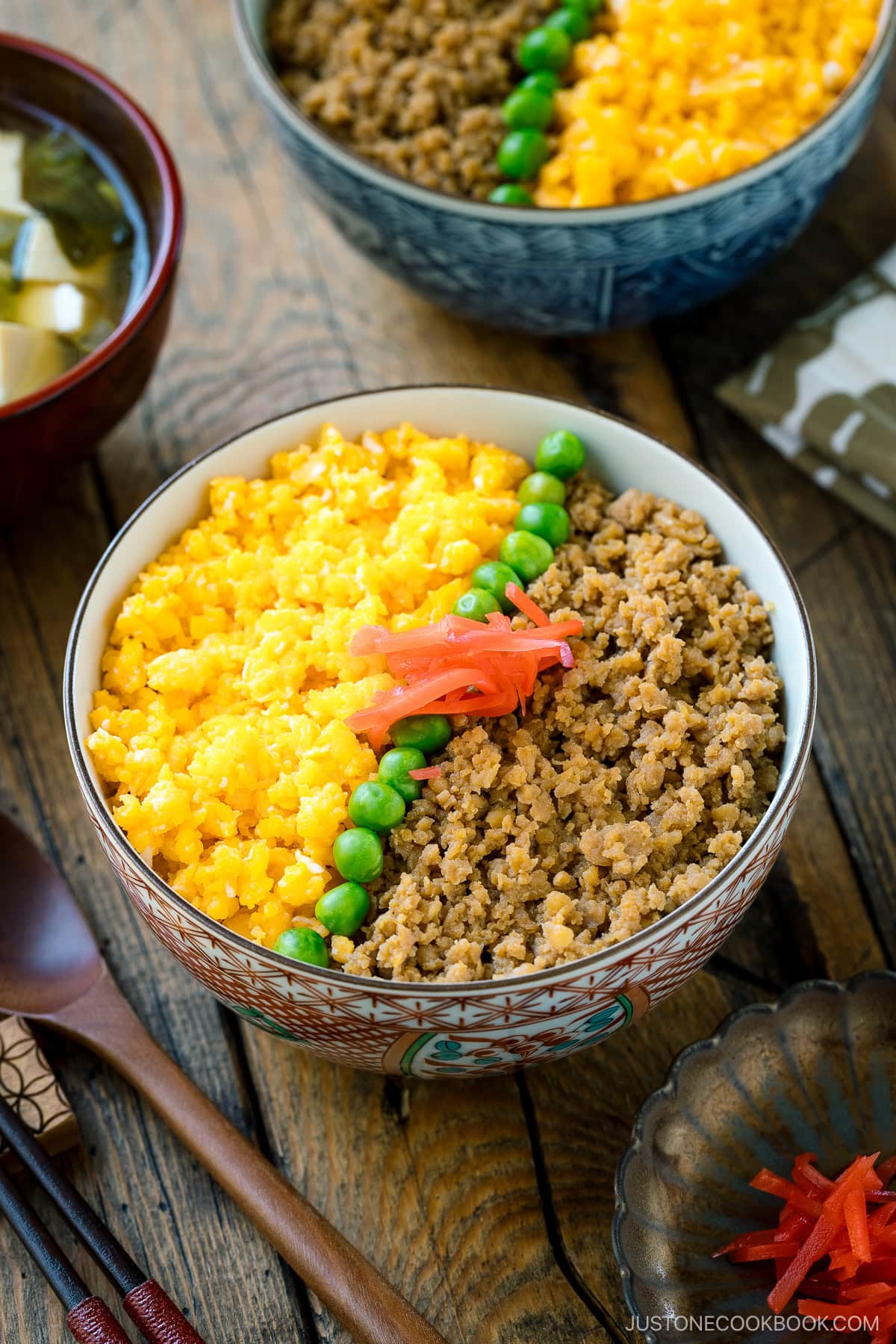
Soboro Don (そぼろ丼) is an easy and delicious Japanese rice bowl with seasoned ground chicken and scrambled eggs. It’s easily one of my favorite bento lunch menus growing up!
The sweet-savory flavor of tender chicken and eggs that get mixed in with steamed rice score big on the comfort level. And what’s not to love when you can put a meal together in just 30 minutes? That’s the virtue of rice bowls! Simple, fast, and well-thought-out, you can never go wrong with it.
Table of Contents
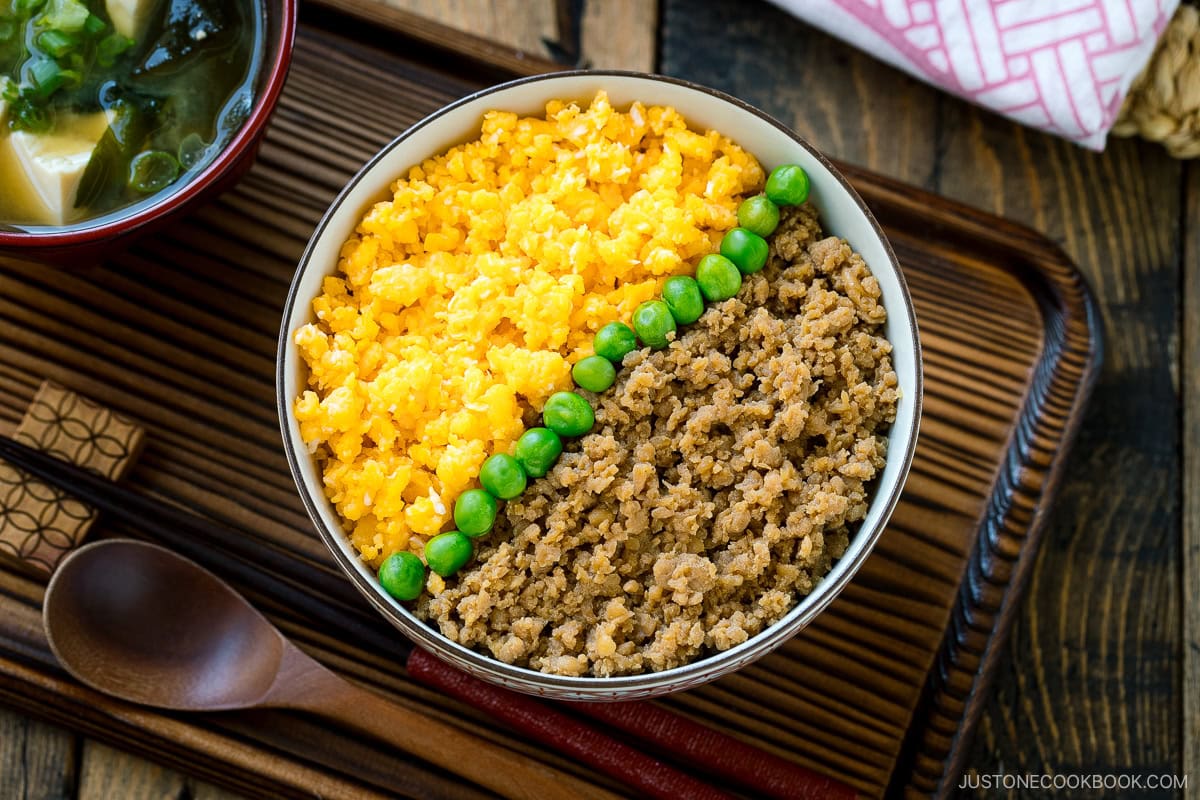
What Does Soboro Mean?
The Japanese word Soboro (そぼろ) refers to ground meat, fish, or eggs that are cooked into fine, crumbled pieces.
Often served over steamed rice and eaten together, you’ll find soboro donburi (そぼろ丼ぶり, or don for short, meaning rice bowl dish) and soboro bento (そぼろ弁当) on the menu in Japan.
Ground chicken is the most commonly used protein for this dish, so we call it tori soboro (鶏そぼろ), literally “chicken ground.”
If you happen to dine at a yakitori restaurant where they serve grilled skewers of different parts of the chicken, try their soboro don. It always tastes the best as yakitori restaurants usually have the freshest and high-quality chicken.
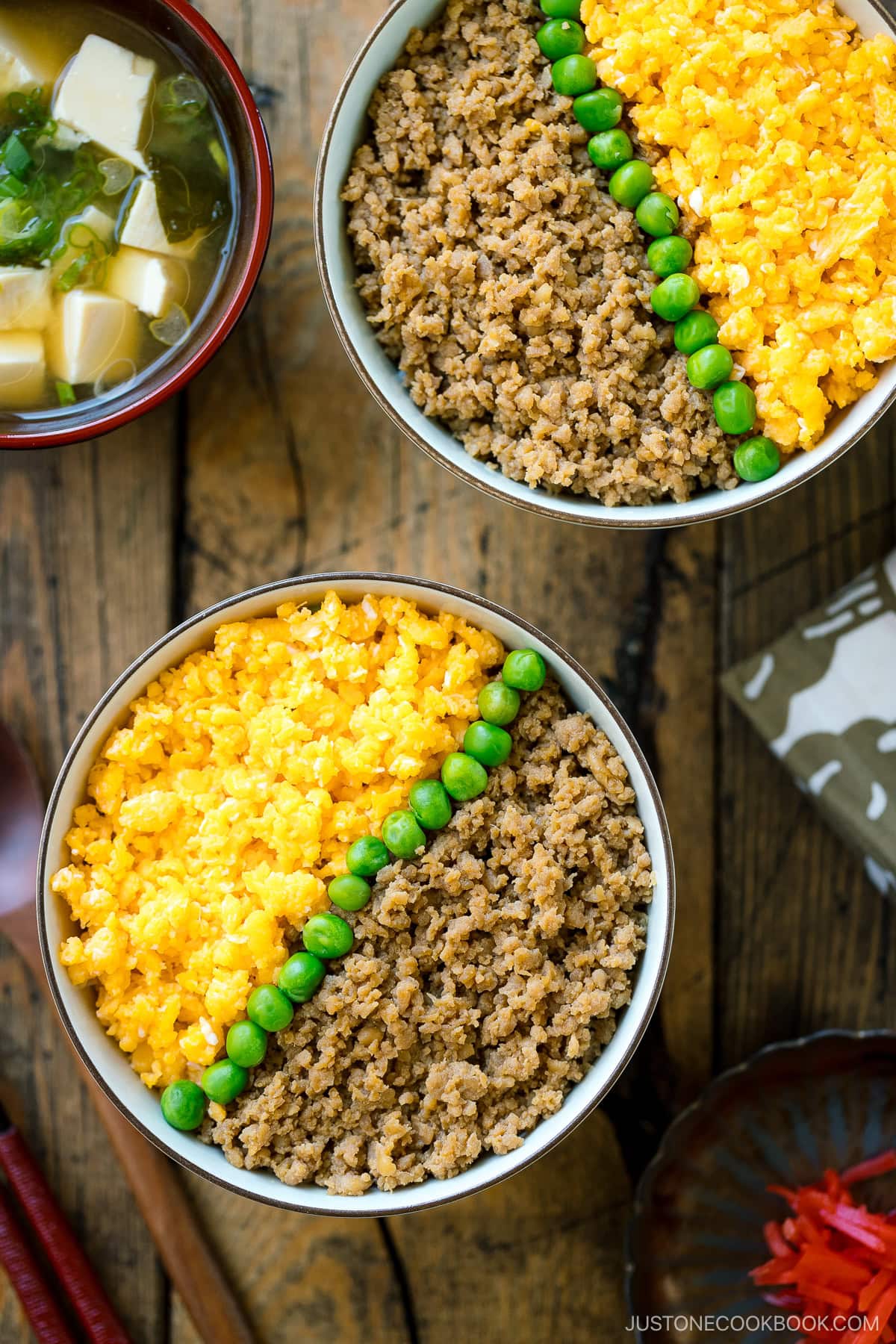
Ingredients for Ground Chicken Bowl
- Ground chicken
- Eggs
- Seasonings: sugar, salt, mirin, sake, and soy sauce
- Steamed rice
- Blanched green vegetables — I used green peas, but you can also use spinach, green beans, okra, or snow peas.
How to Make the Best Soboro Don
- Cook the chicken: Place ground chicken and all the seasonings in a saucepan or frying pan. Cook the chicken until no longer pink.
- Cook the egg: Cook scrambled eggs in a saucepan or frying pan.
- Serve the steamed rice in the bowl, then put seasoned ground chicken, eggs, and green vegetables over the rice.
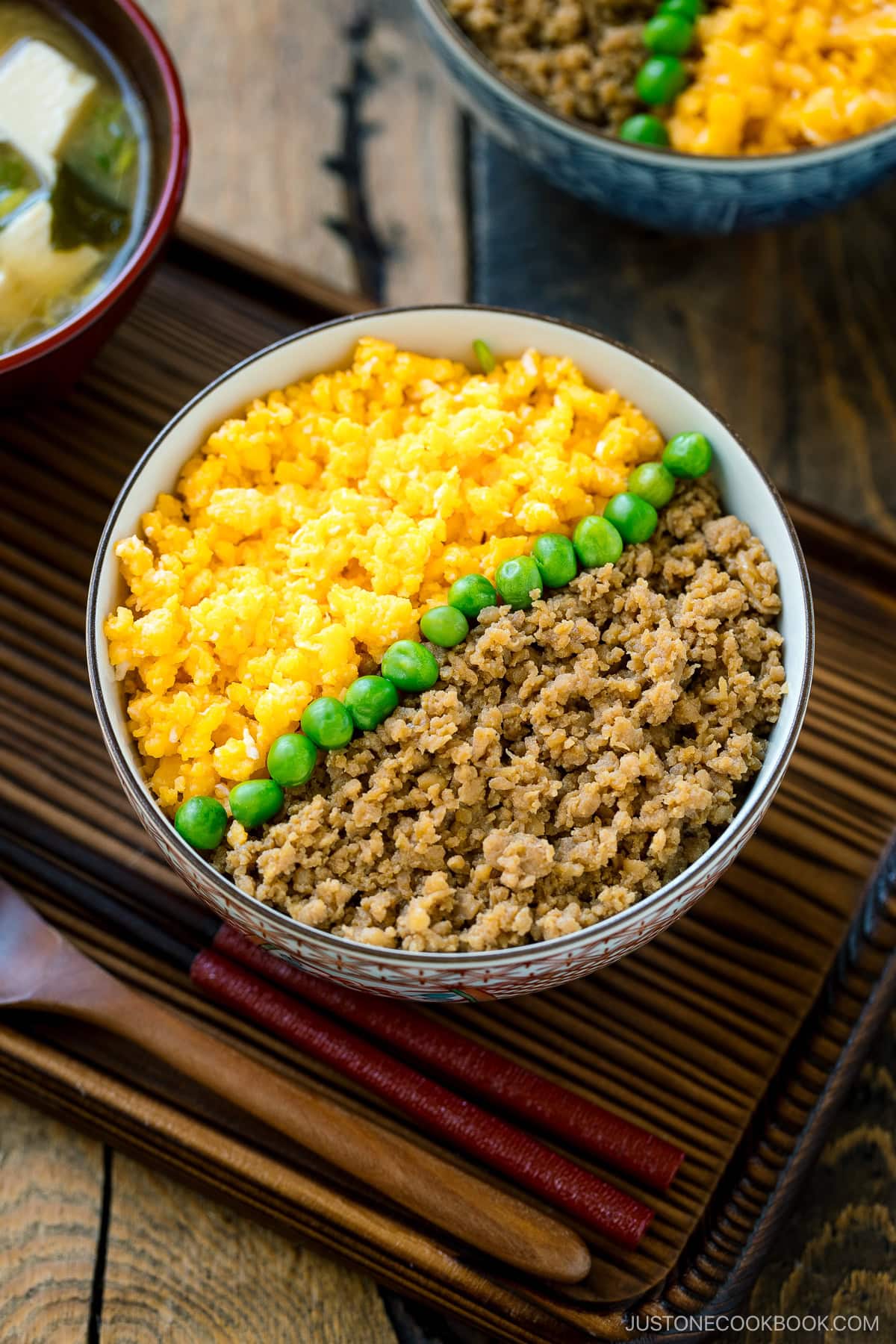
4 Important Cooking Tips to Remember
- Use a saucepan instead of a frying pan. I used to use a non-stick frying pan to make this dish but I found it it’s more effective when I cook in a smaller saucepan. You can stir the chopsticks a bit more vigorously, which allows the eggs or ground chicken to break into even smaller bits.
- Use multiple pairs of long (cooking) chopsticks. Have you tried scrambling your eggs using chopsticks? That’s how we make soboro (cooked ground meat) in Japan! Hold at least 3 pairs of long chopsticks and move them vigorously to jostle the eggs into fine scrambles. Do the same for the ground chicken!
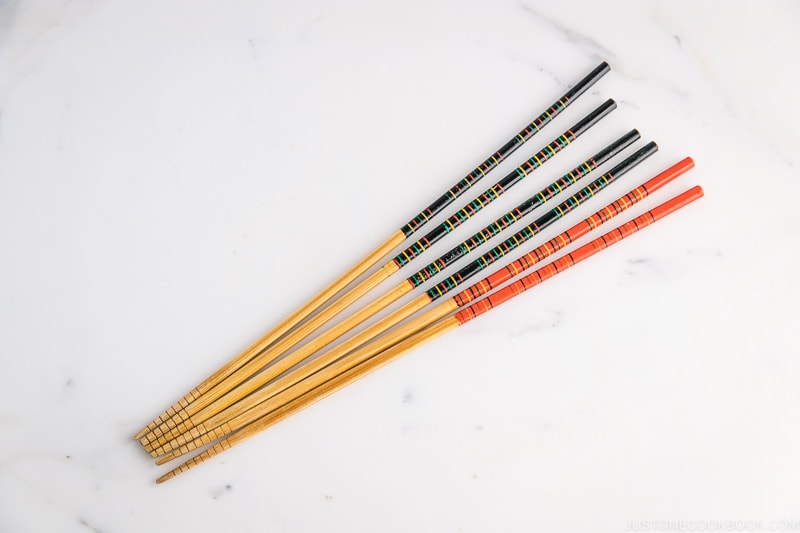
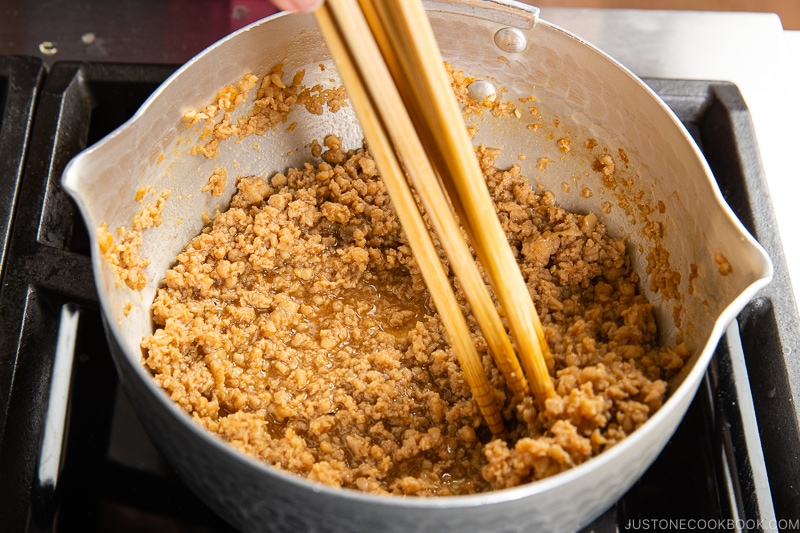
- You don’t need cooking oil. To make soboro, we do not use cooking oil for both eggs and ground meat. Just place the ingredients directly into the saucepan and start cooking! An aluminum pan or yukihira nabe (above) is a bit difficult to wash the residual egg attached to the saucepan. Use a stainless steel or non-stick coating pot so it’s easier to clean.
- Cook on medium-low heat. We always cook the eggs or ground chicken over medium-low heat. Slowly and gently cook while you stir vigorously with chopsticks. This is how you make fine scrambled eggs and Cook on medium-low heat. We always cook the eggs or ground chicken over medium-low heat. Slowly and gently cook while you stir vigorously with chopsticks. This is how you make nice scrambled eggs and ground chicken. Scrambled eggs should not be chunky, and chicken should be well-seasoned, so take your time to make this dish.
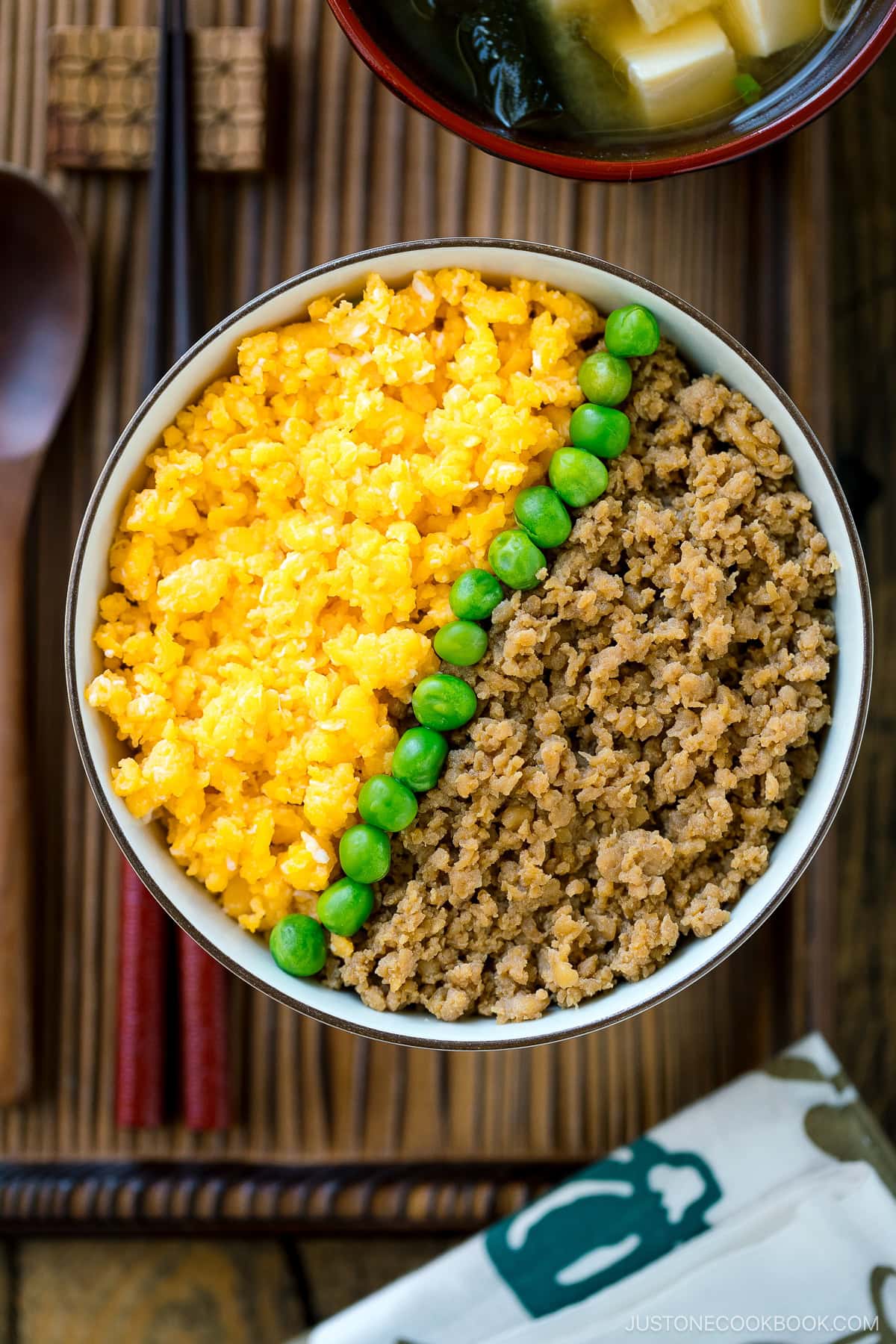
FAQs
Why do you sweeten eggs and chicken?
In Japanese cooking, you’ll find that it’s a common practice to season the eggs and meat with some sugar. The reason we do that is to bring out the flavors of the ingredients, especially when we prepare food that we enjoy at room temperature. The use of sugar also helps to balance the savory seasoning, so you’d achieve full umami for the meal.
Since soboro is served with bland steamed rice, the flavor of the dish would come from the well-seasoned eggs and meat.
You can choose to leave out the sugar or reduce the amount to suit your taste. But if you plan on packing soboro don into a lunch box, don’t skimp on the seasonings. Foods served at room temperature require stronger seasonings to attain the flavors.
How about other protein choices besides chicken?
You can definitely use ground pork or beef (or ground turkey). For creative variations, you can finely chop shrimp or crumble firm tofu, too!
If you’re stumped on what to make for dinner tonight, you can count on soboro don for a quicker-than-take-out option. It packs beautifully for your bento lunch box too!
Hungry for More Easy Rice Bowl Recipes?
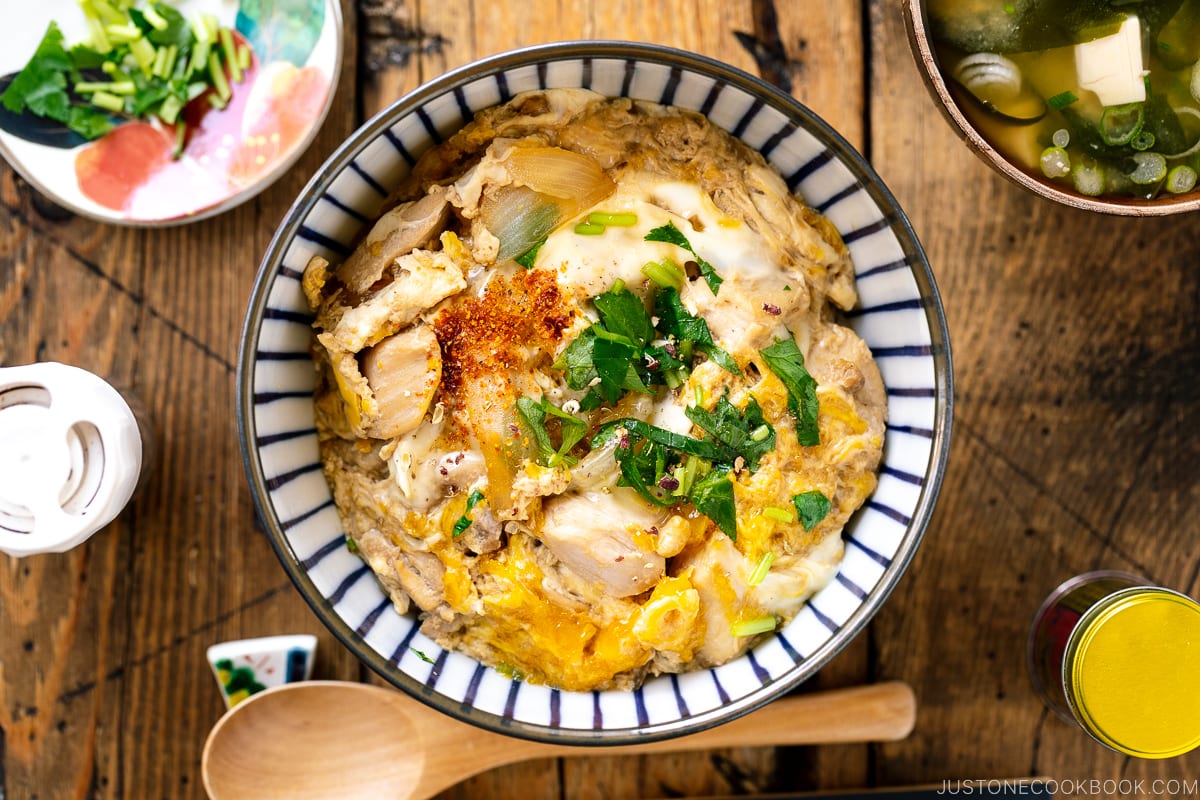
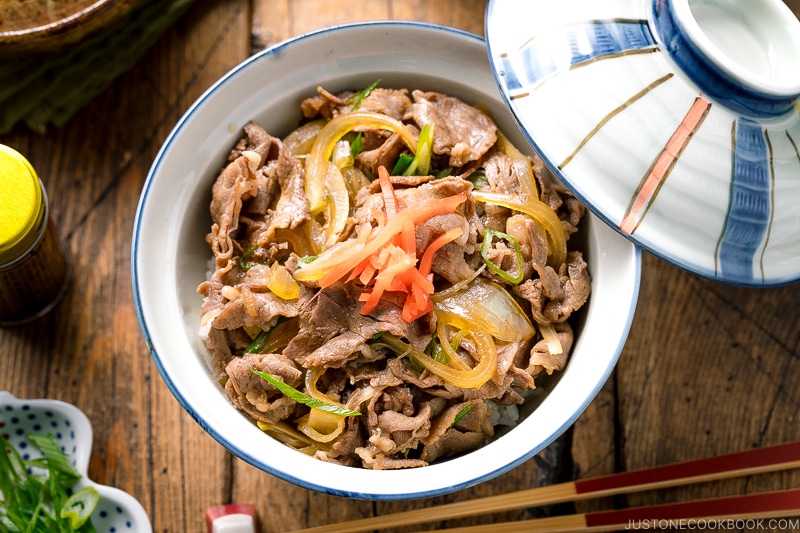
Wish to learn more about Japanese cooking? Sign up for our free newsletter to receive cooking tips & recipe updates! And stay in touch with me on Facebook, Pinterest, YouTube, and Instagram.

Soboro Don (Ground Chicken Bowl)
Video
Ingredients
For the Soboro Chicken
For the Scrambled Eggs
- 3 large eggs (50 g each w/o shell)
- 1 Tbsp sugar (typically, we make the eggs even sweeter than this; if you prefer, reduce the sugar or skip)
- ¼ tsp Diamond Crystal kosher salt
For Serving
- 2 servings cooked Japanese short-grain rice (typically 1⅔ cups (250 g) per donburi serving)
- 2 Tbsp green peas (cooked)
- pickled red ginger (beni shoga or kizami beni shoga) (optional)
Instructions
- Before You Start: For the steamed rice, please note that 1½ cups (300 g, 2 rice cooker cups) of uncooked Japanese short-grain rice yield 4⅓ cups (660 g) of cooked rice, enough for 2 donburi servings (3⅓ cups, 500 g). See how to cook short-grain rice with a rice cooker, pot over the stove, Instant Pot, or donabe. Now, gather all the ingredients. Prepare 3 pairs of long cooking chopsticks.
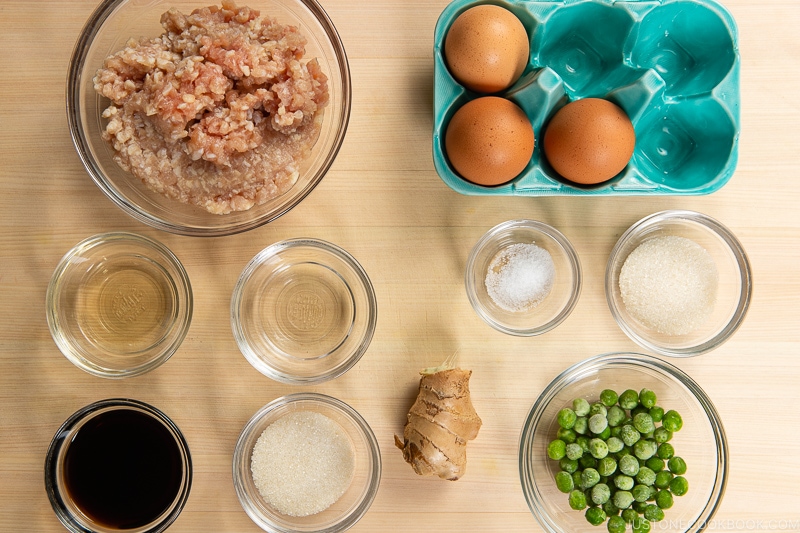
To Cook the Soboro Chicken
- Grate the ginger (I use a ceramic grater). Measure 1 tsp ginger (grated, with juice).
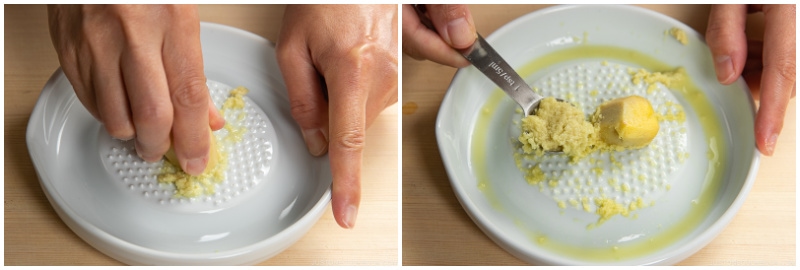
- Combine ½ lb ground chicken, 1 Tbsp sake, 1 Tbsp mirin, 1½ Tbsp sugar, 2½ Tbsp soy sauce, and the grated ginger in a medium saucepan.
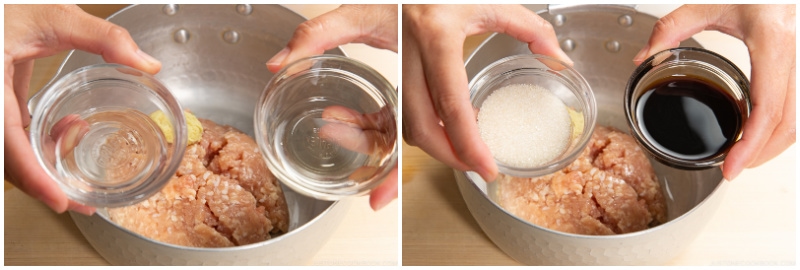
- Mix the chicken with the seasonings using 3 pairs of long cooking chopsticks, breaking up the ground meat into smaller bits.
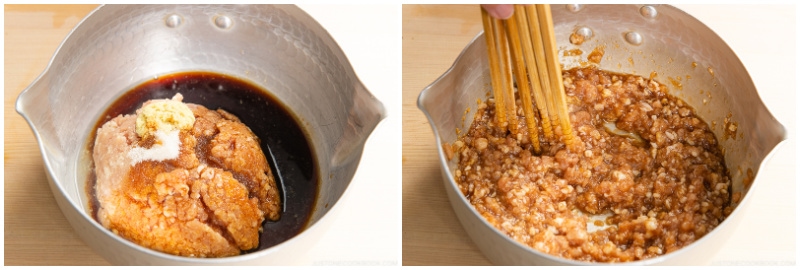
- Now, bring the saucepan to the stove and set it on medium-low heat. Cook the ground chicken mixture, stirring constantly, until it‘s no longer pink.
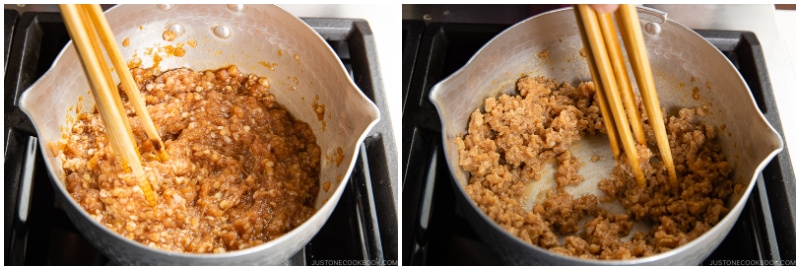
- Soon, the chicken will start to release its juices. Continue to cook until the liquid is almost gone. Turn off the heat and set it aside.
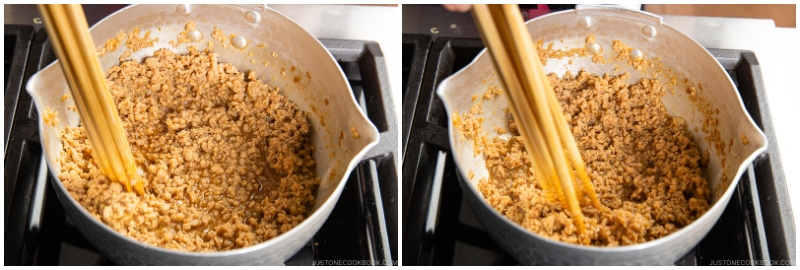
To Cook the Scrambled Eggs
- Add 3 large eggs (50 g each w/o shell), 1 Tbsp sugar, and ¼ tsp Diamond Crystal kosher salt to a medium saucepan. Using 3 clean pairs of long cooking chopsticks (either a different set or the previous set that you washed clean), beat the egg mixture until the sugar is completely dissolved.
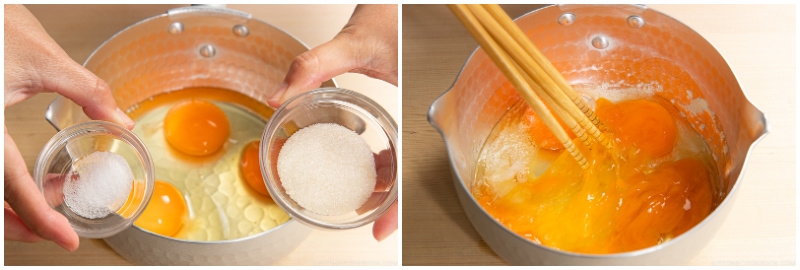
- Set the saucepan over medium-low heat and cook the egg mixture. Stir often to release the cooked egg from the bottom or edges of the saucepan and to keep their bright yellow color.
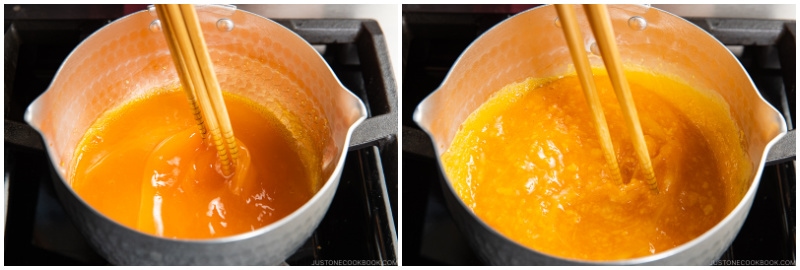
- Stir to break up the bigger pieces into smaller bits. Cook the eggs until they are no longer runny and are soft and fluffy. Once the eggs are done (don‘t overcook them!), set them aside.
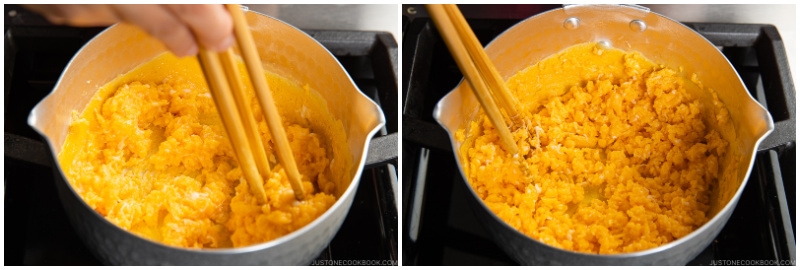
To Assemble
- Serve 2 servings cooked Japanese short-grain rice in individual donburi bowls. Put the ground chicken over half of the steamed rice and the scrambled eggs on the other half. I line up 2 Tbsp green peas down the middle. Garnish with pickled red ginger (beni shoga or kizami beni shoga) on top, if you'd like.
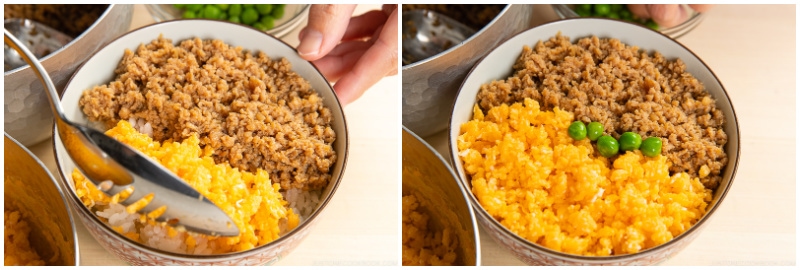
To Store
- You can keep the leftovers in an airtight container and store it in the refrigerator for up to 3–4 days or in the freezer for a month.
Nutrition
Editor’s Note: The post was originally published on April 11, 2011. The pictures and content have been updated and the recipe has been slightly revised on June 21, 2022.
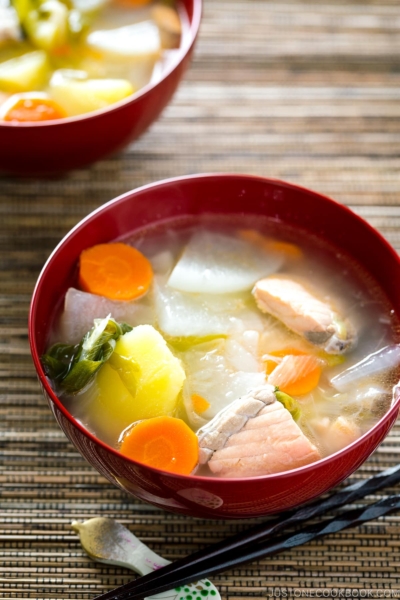
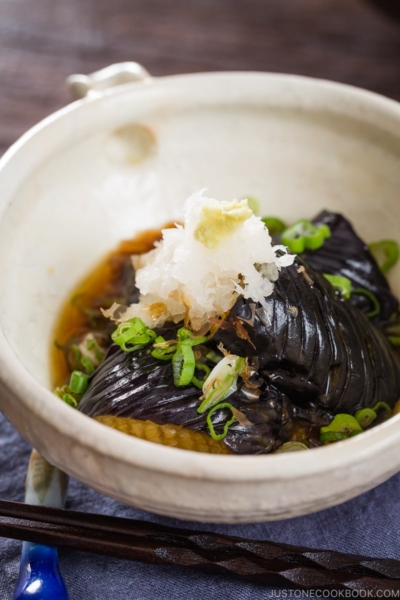
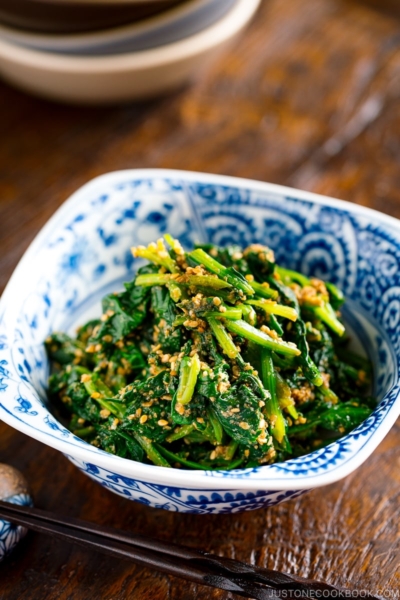
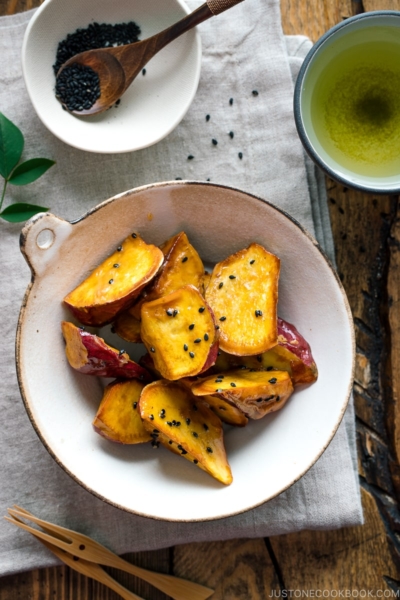




Absolutely delicious. So easy to make too! Wouldn’t change a thing in this recipe.
Hi there! We are so happy to hear you enjoyed the dish!
Thank you for trying Nami’s recipe! 🤗
おいしい!
I’ve loved all the recipes I’ve tried so far, but man! This was my favorite so far. So good! Made recipe as is, no changes.
Hello there! Thank you for your kind feedback!
We are happy to hear you enjoy Nami’s recipes! Thank you for taking the time to rate the recipe!
So this was something I’ve been wanting to try making for some time; think I had it in a little cafe in Kyoto, kind of a home-cooking place that a nice person working in a shop kindly pointed me towards (I asked her where she liked to eat lunch at, and she gave me directions right away.) Your recipe was delicious! I’ll be making this again– I work hard for a living too, and I’ll be taking this to work with me for my own lunches. Thank you so much for the recipe!
Hello, Suzanne. We are happy to hear that Nami’s recipe produced a dish similar to the Kyoto meal you experienced.
Thank you very much for trying Nami’s recipe!
A few years back, I ate this dish at a SF Peninsula Japanese restaurant and longed for a recipe. JOC had one and it matched the deliciousness I had remembered. JOC is my go to for authentic and delicious Japanese food.
Hi Ron! Aww. We’re glad to hear Nami’s recipe was delicious, as you recall.
Thank you so much for giving it a try and for your thoughtful feedback.🤗